When it comes to enhancing the aesthetic of your home, the flooring plays a pivotal role. Among the myriad of options available, the concept of combining tile and wood flooring stands out for its ability to merge functionality with style. This innovative approach not only elevates the overall look of your space but also opens up a world of creative possibilities.

Imagine stepping into a kitchen where the warmth of wood floors seamlessly transitions into the elegance of ceramic tiles, or a bathroom where tile floors offer practicality while wood accents add a touch of natural beauty. The combination of tile and wood flooring in a way that suits your taste and lifestyle can transform these everyday spaces into unique showcases of design.
The art of combining these two materials in flooring design isn’t just about aesthetics; it’s also a practical choice for modern homes. While wood floors bring warmth and a classic appeal, tiles offer durability and ease of maintenance, especially in high-moisture areas. By mixing tile and wood, you not only create an eye-catching look but also enjoy the benefits of both materials in different zones of your home.
Whether it’s the kitchen, bathroom, or another area of your home, the combination of tile and wood offers endless possibilities to create a unique, stylish, and functional floor. In this guide, we’ll delve into how to combine tile and wood flooring, covering everything from design ideas to installation tips, helping you to create a space that you’ll love and that will last for years to come.
How to Combine Tile and Wood Flooring
When planning to combine wood and tile flooring, it’s crucial to understand the core principles that make this combination work both functionally and aesthetically. The fusion of these two materials can lead to a stunning and practical flooring design when done correctly.
Benefits of Combining wood and tile Flooring
- Aesthetic Appeal: Combining tile and wood flooring creates a visually stunning impact. The contrast between the natural look of wood and the sophistication of tile can create a unique aesthetic in your home.
- Functional Diversity: Tile is known for its durability and suitability in high-moisture areas like kitchens and bathrooms. On the other hand, wood floors add warmth and a timeless charm to living spaces and bedrooms.
- Versatility in Design: The combination of these two materials allows for creative freedom. From classic to modern, you can select from a variety of shapes, colors, and patterns to match your home’s style.
- Increased Property Value: Homes with a thoughtful blend of tile and wood flooring often see an increase in market value due to their enhanced appeal and unique design.
The Importance of Planning and Selection
- Careful Planning: To successfully combine wood and tile flooring, careful planning is essential. This involves considering the layout of the space, the transition between the two materials, and how they will complement each other.
- Selecting the Right Materials:
- Types of Wood: Choose hardwood varieties known for their durability and aesthetic appeal. Consider hardwood floors that can withstand foot traffic and match your home’s tone.
- Types of Tile: Ceramic tiles are a popular choice due to their durability and range of designs. However, for a more natural look, natural stone tiles can be an excellent option.
- Consideration of Space: The function of the room plays a vital role in material selection. For instance, ceramic or natural stone tiles are ideal for high-moisture areas, whereas hardwood floors are better suited for living areas.
- Matching the Aesthetic: When combining wood and tile flooring, consider the overall color scheme and aesthetic of your home. The goal is to achieve a cohesive look that seamlessly integrates the two materials.
By understanding these basics, homeowners can make informed decisions about their flooring design, ensuring a harmonious blend of wood and tile that is not only stylish but also tailored to their specific needs.
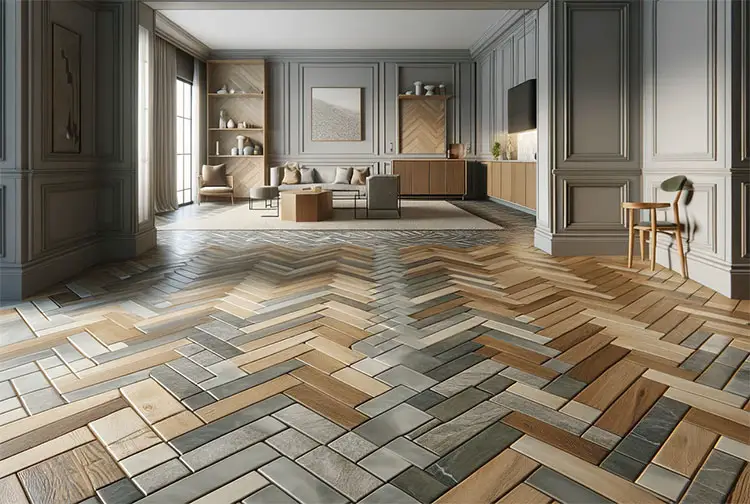
Design Considerations for Tile and Wood Flooring
When merging wood and tile flooring, several design elements are pivotal in ensuring that the final outcome is both aesthetically pleasing and functionally sound. These considerations range from the visual aspects like color and shape to practical concerns like durability and moisture resistance.
Visual Design Elements
- Color Scheme: The choice of colors greatly influences the room’s ambiance. Selecting a color scheme that complements both tile and wood flooring is crucial. This could involve matching tones for a seamless look or contrasting colors for a bold statement.
- Shape and Pattern:
- Tile Shapes: Tiles come in various shapes, including square tiles, rectangular, and hexagonal options. The shape you select can drastically change the room’s appearance.
- Wood Plank Patterns: Wood planks can be arranged in numerous ways, such as traditional straight lines or a more intricate herringbone pattern. The pattern can add depth and interest to your floor design.
- Finish:
- Tile Finish: Choose between glossy, matte, or textured finishes for tiles, each offering a different visual and tactile experience.
- Wood Floor Finish: The finish on hardwood floors can range from high gloss to a more natural matte, impacting both the look and feel of the flooring.
Practical Design Considerations
- Durability:
- Tiles: Tiles, particularly ceramic and natural stone, are known for their durability and resistance to wear and tear.
- Hardwood: Selecting hardwood that is known for its strength and longevity is important, especially in high-traffic areas.
- Scratch Resistance:
- Tile Floors: Most tiles are highly scratch-resistant, making them suitable for areas with pets or heavy furniture.
- Wood Floors: Opt for hardwood floors with a high-quality finish that can withstand scratches and dents.
- Suitability for High-Moisture Areas:
- Tiles: Ideal for bathrooms, kitchens, and entryways, tiles offer excellent water resistance.
- Wood: Certain types of wood and finishes are better suited for moist environments. It’s important to select accordingly.
- Maintenance Requirements:
- Tile Maintenance: Tiles generally require less maintenance, often needing just regular cleaning.
- Hardwood Maintenance: Wood may require more care, such as periodic refinishing, to maintain its appearance and durability.
By carefully considering these design factors, you can ensure that your combination of tile and wood flooring not only enhances the room’s aesthetic but also meets the practical demands of your household. The key is to strike a balance between beauty and functionality, resulting in a flooring design that is both stylish and durable.
Installation Techniques for Tile and Wood Flooring
Proper installation is key to achieving a seamless and durable combination of tile and wood flooring. This section outlines various methods and essential tools needed to ensure a successful installation.
Installation Methods
- Inlay Technique:
- Description: Inlay involves embedding tiles within the wood floor, creating an intricate, eye-catching design.
- Application: Ideal for creating decorative borders or accent areas in larger rooms.
- Plank Arrangement:
- Description: This method focuses on how wood planks are laid out in relation to the tiles.
- Patterns: Common arrangements include straight lay, staggered, or herringbone patterns for added visual interest.
- Transition Ideas:
- Straight Transition: This is where tile meets wood in a straight line, suitable for clean, modern designs.
- Curved or Wavy Transitions: For a more organic look, tiles can be cut to create a curved transition to the wood area.
- Mixed Material Borders: Use a combination of tile strips and wood planks to create a unique transition zone.
Essential Tools for Installation
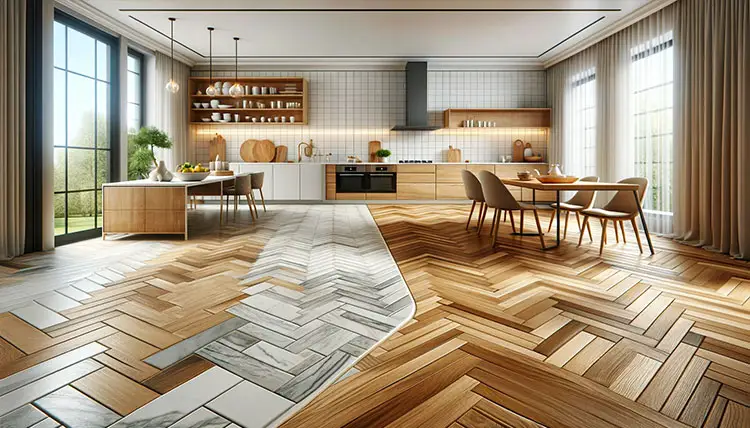
- Measuring Tape: Essential for accurate measurements, ensuring that both tiles and wood planks fit perfectly in the designated space.
- Chalk Line: Used to mark guidelines on the subfloor, helping to align tiles and wood planks evenly.
- Tile Cutter and Saw: Necessary for cutting tiles and wood to the desired size and shape.
- Leveling Tools: Ensure that the surface is even before, during, and after laying down tiles and wood.
- Adhesives and Grout: Select the right adhesives for both tiles and wood, and use grout for filling spaces between tiles.
- Nail Gun: For securing wood planks, a nail gun can provide a more efficient and secure installation than traditional hammering.
- Spacers: Particularly important for tile installation, spacers help maintain consistent gaps between tiles for an evenly installed floor.
Installation Tips
- Careful Planning: Before beginning, plan the layout and consider the transition between the two materials.
- Consider Room Conditions: Factor in room conditions such as humidity and temperature, which can affect the installation of wood floors and tiles.
- Install Wood Floors in Dry Conditions: Ensure that the area is dry before installing wood floors, as moisture can cause warping.
- Level the Subfloor: An uneven subfloor can lead to problems with both tile and wood flooring. It’s crucial to level the subfloor before installation.
- Sealing and Finishing: After installation, apply the necessary sealant and finish to protect the flooring and enhance its appearance.
By using these techniques and tools, you can ensure that your tile and wood flooring is not only aesthetically pleasing but also installed correctly, providing a durable and long-lasting surface for your home.
Creative Ideas for Combining Tile and Wood Floors
The fusion of tile and wood flooring is not just a testament to durability and functionality, but also an opportunity for creative expression. This section explores a variety of design ideas that can transform your space into a visually captivating area.
Innovative Design Patterns
- Herringbone Patterns:
- Description: A classic and elegant pattern where wood planks or tiles are laid in a zigzag arrangement.
- Application: Ideal for adding sophistication to living rooms or hallways.
- Mosaic Accents:
- Description: Incorporate mosaic tile designs as focal points within a wood floor. This can be in the form of small insets or larger decorative sections.
- Placement: Perfect for creating a unique feature in entryways or as a centerpiece in large rooms.
- Seamless Transitions:
- Description: Blending tile and wood in a way that the transition is hardly noticeable, creating a fluid, cohesive look.
- Technique: Gradual blending of colors and patterns, or using similar shapes in both materials.
Experimenting with Shapes and Textures
- Hexagonal Tiles:
- Visual Appeal: Hexagonal tiles can provide a modern and geometric contrast to the straight lines of wood planks.
- Combination: Pair with narrow wood planks for a striking, modern look.
- Rectangular Planks:
- Design Flexibility: Rectangular wood planks offer a traditional look but can be laid in various patterns (like staggered or basketweave) for a contemporary twist.
- Tile Pairing: Combine with large format tiles for a bold, contrasting effect.
- Textured Tiles:
- Sensory Experience: Tiles with a textured finish can add a tactile dimension to your flooring.
- Wood Pairing: Smooth-finished wood provides a pleasing contrast to textured tiles.
Color Coordination and Material Contrast
- Tone Matching:
- Harmony: Choose tiles and wood in similar tones for a harmonious, unified look.
- Contrast: Alternatively, opt for contrasting colors to create a bold and dynamic effect.
- Material Mix:
- Natural and Manufactured: Combine the natural appeal of hardwood floors with manufactured tiles like ceramic or porcelain for an interesting mix of materials.
- Finish Variety: Play with matte and glossy finishes to add depth and interest.
Practical Applications in Different Areas
- Kitchen: Use durable tiles in high-traffic areas with wood accents to add warmth.
- Bathroom: Opt for water-resistant tiles with wood elements to create a spa-like ambiance.
- Living Room: Combine large-format tiles with wide wood planks for an expansive and open feel.
By exploring these creative ideas, you can combine tile and wood flooring in your home in ways that are both visually appealing and functionally effective. These designs not only cater to diverse aesthetic preferences but also ensure that your flooring remains a timeless and stylish feature of your home.

Tips for Mixing Tile and Wood in Different Spaces
Combining tile and wood flooring effectively in various areas of your home requires a thoughtful approach to maintain both style and functionality. Here are some tips for integrating these two materials in key spaces like kitchens, bathrooms, and entryways.
Kitchens
- Functionality First: In kitchens, where durability and ease of cleaning are paramount, use tiles in high-traffic and spill-prone areas near the sink and stove.
- Warmth and Style: Introduce wood flooring in dining or open-plan areas to add warmth and a natural feel.
- Cohesive Design: Use a consistent color scheme or similar tile and wood finishes to unify the space, even with different materials.
Bathrooms
- Moisture-Resistant Tiles: Opt for ceramic or natural stone tiles for wet areas due to their water resistance and durability.
- Wood Accents: Use wood floors or wood planks in drier areas or as an accent feature to add a touch of elegance and warmth.
- Seamless Transitions: Ensure a cohesive look by matching the tone or finish of the tile with the wood, creating a seamless transition between the two.
Entryways
- Durability Focus: Entryways benefit from the durability of tiles, especially in high-moisture areas or regions with harsh weather.
- Welcoming Wood: Introduce wood flooring to add a welcoming, homey feel as one transitions further into the home.
- Decorative Inlays: Consider using tile inlays within a wood floor for an eye-catching, durable entrance design.
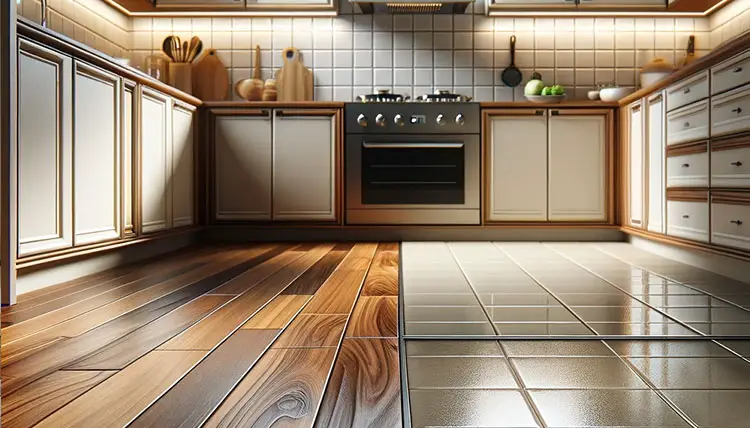
Maintenance and Longevity of Combined Flooring
Ensuring the longevity and beauty of your tile and wood flooring requires regular maintenance and the use of high-quality materials.
Care and Maintenance
- Regular Cleaning: Sweep and mop wood floors regularly, and clean tiles with appropriate cleaners to prevent dirt build-up.
- Protective Finishes: Apply protective finishes to wood floors to guard against scratches and moisture.
- Prompt Spill Cleanup: Quickly address spills, especially on wood floors, to prevent water damage.
- Rug Use: Place rugs in high-traffic areas to reduce wear on both wood and tile.
Selecting the Right Materials
- High-Quality Tiles: Choose durable and high-quality ceramic or natural stone tiles that can withstand wear and tear.
- Durable Wood: Opt for hardwood floors known for their durability and resistance to scratching.
- Suitable Finishes: Select finishes for both tile and wood that are appropriate for the room’s function, ensuring longevity and ease of maintenance.
By considering these tips and focusing on regular maintenance, you can enjoy the benefits of combining tile and wood flooring in your home, creating spaces that are not only stylish and unique but also built to last for years to come.
Conclusion
The harmonious blend of tile and wood flooring offers a unique opportunity to elevate the aesthetic and functionality of your home. Throughout this guide, we’ve explored various aspects of this stylish combination, from the basics of combining these two materials to creative design ideas and practical installation tips.
We’ve delved into the benefits of using both tile and wood flooring in your home, highlighting how they can complement each other to create a visually appealing and durable surface. Important design considerations, including color schemes, shapes, and finishes, were discussed to help you create a cohesive and attractive look.
Installation techniques, focusing on inlay, plank arrangement, and transition ideas, were outlined, emphasizing the importance of using the right tools, such as measuring tape, chalk, and other necessary equipment for a successful installation. Creative design ideas, such as herringbone patterns, mosaic accents, and various tile shapes, were showcased to inspire your own unique flooring projects.
Furthermore, we provided specific tips for effectively mixing wood and tile in different spaces like kitchens, bathrooms, and entryways, ensuring both functionality and style. The significance of regular maintenance and the selection of high-quality materials to ensure the longevity of your flooring was also emphasized.
As you embark on your journey to combine wood and tile flooring, remember that this venture allows for a great deal of creativity and personalization. Don’t hesitate to experiment with different combinations and layouts to find the perfect match for your home. And for those more intricate designs or when in doubt, consulting a professional can provide valuable insights and assistance.
We encourage you to get creative and explore the many possibilities that tile and wood flooring can offer. With careful planning and a touch of creativity, you can create a space that is both unique and timeless, one that you will enjoy for many years to come.


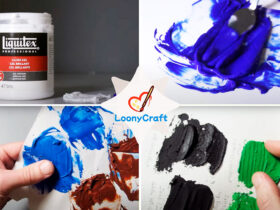

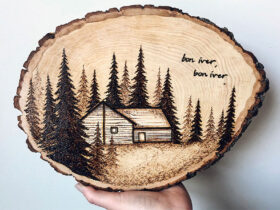
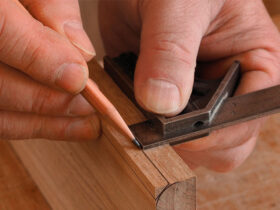





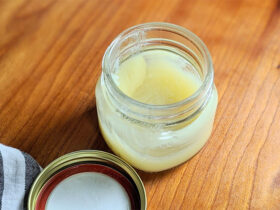

Leave a Reply